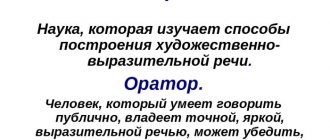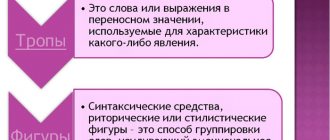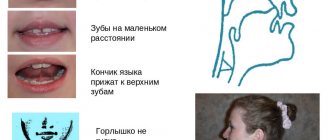Definition of the concept
The colloquial style of a text is a style that includes set expressions, words, phraseological units, and cliches that are characteristic of oral speech.
In works of art, dialogues or monologues of characters are usually written in a conversational style to give more reality and authenticity. Conversational style of speech is the style through which communication occurs between people in an informal setting. The second name is “everyday style”, because this is how people talk in everyday life.
Morphological characteristics
In everyday communication, people strive to speak more simply and dynamically, and avoid “complex” forms of parts of speech. In particular, in colloquial speech they note:
- absence of participles (“raised”, “raised”), gerunds (“raised”, “put”). Also, short adjectives (“beautiful”, “kind”) are not used or only slightly used;
- widespread use of pronouns (“I”, “you”, “he”), particles (“only”, “hardly”, “let”, “what the”), interjections (“oh!”, “eh!”) . Sometimes they can consist of entire replicas: “(Is it) you?”, “And he (what did he do)?”, “Let (it be so)!”;
- reduced, compared to other speech styles, proportion of nouns;
- special vocative form: “Mom!”, “Vasya!”;
- frequent use of truncated forms of nouns (“ten kilograms”, not “kilograms”) and functional parts of speech (“so that”, “at least”);
- There is no declension for complex and compound numerals. For example: “Thirty forks are missing”, “Who wrote about twenty-six commissars?”;
- frequent use of present tense verbs in conversations about the past: “I was already going to bed yesterday, and he’s calling.”
Signs of a conversational style of speech
Conversational speech is based on spontaneity and simplification of statements. The main features include the following:
- Use of abbreviated, shortened words. For example, wages are wages, maternity leave is maternity leave, a three-story house is a three-story building.
- Removing some words if the meaning of the sentence is clear without them, shortening complex sentences. For example, I'm hungry - I'm hungry,
- Using a simplified form of the word. For example, today is today, now is right now, smile is smile.
- Insertion of particles, introductory words, interjections, addresses.
- Use of extra-lexical means (stress, tempo, intonation).
- The use of etiquette clichés that were developed in the process of repeating similar situations. For example, “Do you need help? Hello". The words in this case are in the order in which it is more convenient for a person to pronounce them.
- The use of words with specific expressiveness or expressiveness in speech. For example, I’m tired of everything (tired of it), shirk (work a lot), quit (quietly leave).
Example of spoken language:
A month before leaving Moscow, we ran out of money - it was dad who was preparing for fishing... And then the fishing began.
They use spoken language to communicate with each other in society. And beauty and coherence already depend on a person’s education and literacy. Therefore, speech can be either close to bookish or contain obscene expressions. It is not used in the preparation of scientific literature or official documents.
Lexical means
Of course, colloquial speech has the most striking differences due to the abundance of special words in it, which are acceptable and appropriate only here. The linguistic palette of everyday style is bright and varied due to its richness in emotions. Often, familiar literary and artistic means and techniques are not enough to express the full range of feelings:
- Wide use of stress, intonation, changes in timbre and rhythm of the voice to add additional color to speech.
- An abundance of colloquial vocabulary, vernacular, jargon, vulgarisms (right now, hot, hard worker, minibus, mobile, cash).
READ What you can do at home together: the most interesting ideas
- Frequent phraseological phrases that are in the nature of evaluative generalizations (the hunchbacked grave will correct), the use of words in a figurative meaning (window - break, hat - mistake).
- The merging of a word with its meaning or assessment, when it is clear without additional explanation (opener, trickster, good fellow, smart guy).
- The use of words with diminutive or augmentative suffixes (blushing, pretty, little book, little chair).
- Simplification and shortening of long words or names (grade book - grade book). Borrowing foreign language vocabulary (lol, fake, hype). Addition of words (slow-witted, parasite).
- Multi-prefixed verbs with expressive coloring (hold up, don't get enough sleep, throw away).
Vernacular
This group of words and expressions does not fit into the norms and framework of literary speech. It carries shades of simplification, rudeness, and reduction of meaning.
Some scientists distinguish vernaculars into a separate lower layer of vocabulary, since they are used by people to convey a special attitude towards a subject or object, that is, they act as a full-fledged stylistic linguistic unit. The second group of researchers classifies vernaculars as a special group that goes beyond the literary language.
The use of colloquial words is deliberate when it is included in the narrative by educated people in order to give the story a special tone, specific coloring, and imagery. This is what publicists, journalists, speakers, and politicians do. In addition, this is found everywhere in the everyday speech of the average city resident. But even those deprived of education can use vernaculars. This situation is already deliberate in nature, when there is not enough intelligence and vocabulary to express thoughts differently.
Colloquial speeches are quickly remembered due to their vivid meanings. They are individual, often do not have synonyms, related or cognate words.
Jargonisms
In modern Russian, there are three groups of slang words: youth slang, professional slang (among workers' organizations - construction workers, factory workers, truck drivers) and camp or prison slang (it is used in prisons).
READ Meeting a girl's parents: the most important nuances at the first meeting
Slang is most widespread in everyday speech. The sources of its occurrence are considered to be student communities, schools, and gymnasiums. Its appearance is associated with the desire of young people to stand out and be different from those around them. All slang words have synonyms in the literary language (dormitory - hostel, correspondence - distance learning, kurach - course work, teacher - teacher). Jargon also includes words that convey the attitude or state of the speaker (high, awesome, laugh, labor, cool).
Vulgarisms
These are the most brightly colored words allowed in speech. Vulgarisms are rude, aggressive or even vulgar in nature. They are far beyond the boundaries of literary language, but their use is sometimes acceptable as an additional artistic device.
Vulgarisms include all curses, abusive expressions, words that convey strong negative emotions, taboo words and blasphemy (die - die, lupals - eyes, eat - eat, muzzle - face).
The presence of a large number of vulgarisms in speech indicates a low culture of behavior, lack of education and spirituality.
Distinctive features of conversational style
The conversational style has certain features that distinguish it from other book styles:
- Used only in dialogues or monologues.
- Emotionality, imagery, simplicity.
- A loose selection of words (jargon, obscenities, professional terms, dialectisms, phraseological units), which are used interspersed.
- Failure to follow logic when the thread of conversation is lost and people abruptly move on to another topic.
- Frequent use of interrogative and exclamation sentences.
- Evaluativeness, that is, expressing one’s clear opinion, explicit condemnation or support.
- Intermittent speech.
FUNCTIONAL STYLES, SUB-STYLES OF SPEECH, GENRES
1. It is known that depending on the purpose of communication, the form of communication, the addressee, speech situations are grouped and correlated with one or another sphere of human activity, for example, educational, business, social, etc. In this sense, speech is also typified: some means of language become preferable in situations business sphere of communication, others - in the scientific sphere, etc.
functional styles are formed - varieties of literary language. The term “functional style” itself emphasizes that varieties of literary language are distinguished on the basis of the function (role) that the language performs in each specific case. For example, for a scientific article, what is important first of all is accuracy in the designation of concepts, and in fiction and journalism - emotionality and figurativeness of expression. At the same time, in each specific case, special linguistic means are selected, and in some cases, the method of presenting these means is also important.
The word style (Greek stylo) in ancient Greek meant a pointed stick, a rod for writing on wax tablets. Later this word acquired the meaning of “handwriting”, and later began to denote the manner, method, and features of speech.
So, in linguistics, style is usually understood as a type of literary language that serves some aspect of social life, has a special sphere, a certain range of topics, and is characterized by special conditions of communication. It is called functional because it performs a certain function in society in each specific case.
The doctrine of styles goes back to M.V. Lomonosov, who wrote: “... the Russian language through the use of church books in decency has different degrees: high, mediocre and low. This comes from three types of sayings in the Russian language.”
A functional style is created by a combination of neutral linguistic means and special means used only in this style. Depending on the basis of the classification, various types of functional styles are distinguished. The communicative and everyday function serves as the basis for contrasting the conversational style with the book styles . In turn, according to specific stylistic manifestations, in accordance with the spheres of social activity, specific book functional styles are distinguished.
The traditional classification of styles can be presented as the following diagram:
Each functional style is a complex system, the features of which are manifested in both oral and written forms of its implementation (albeit to different degrees). At the same time, stylistic differences cover all language levels: word pronunciation and stress placement, morphological means, lexical and phraseological composition, characteristic syntactic structures.
In functional styles, as a rule, substyles that meet the requirements of a specific type of activity. Thus, in the scientific style there are distinguished the scientific sub-style (academic sphere), scientific and technical (engineering sphere), educational and scientific (higher education sphere) and other sub-styles.
Note that the peculiarity of each style is not only the scope and purpose of communication, general requirements, conditions of communication, but also the genres in which it is implemented.
What is a genre? Let's define this concept. A genre is a specific type of text that retains the general features of a particular style (its dominant), but at the same time is characterized by special compositional speech structures and linguistic means.
For example, in the literary and artistic style there are such genres as novel, short story, story, poem; in a journalistic style - essay, report, interview, feuilleton; in official business - application, order, certificate, letter of guarantee; in a scientific style - monograph, report, abstract, abstract, etc.
From the definition it is clear that each genre (speech work) requires its own linguistic means of expression and a special way of organizing them. At the same time, it is always necessary to remember that the choice of stylistically colored words is justified, so that the linguistic means used belong to the style to which this or that genre belongs. Otherwise, this will lead to misinterpretation, ambiguity and will indicate a low level of speech culture.
Consequently, we can talk about the existence of so-called style-forming factors , which are designed to set the parameters for each functional style. In particular, this can be observed in the selection of linguistic means (orthoepic, grammatical, lexical) that form a certain system. This system is manifested in the interaction of neutral (commonly used) units and special (stylistically colored) units. Note that style-forming factors have a strict hierarchy. Among them, we highlight three main ones: sphere, purpose and method of communication. They determine the choice of the type of speech, its form, the method of presentation and the requirements of certain qualitative characteristics.
Let us clarify the content of the listed style-forming factors.
Thus, it is customary to distinguish the following spheres of communication: socio-political, scientific, legal, everyday, etc.
The purpose of communication can be not only the transfer of information, but also persuasion, prescription, aesthetic impact, establishing contact, etc.
As for the method of communication, on the one hand, there are mass and personal methods, and on the other – contact, non-contact and indirect contact.
If the speaker or writer has a good understanding of the characteristics of these factors, it will not be difficult for him to determine or choose a style.
Of course, in practice we often see a mixture of styles. In a live speech stream, styles can interact. This occurs especially often in conversational and everyday style of speech. But in order to understand the degree of permissibility of using different manifestations of language, you need to be well aware of the norms and qualitative characteristics inherent in a particular style. It is for this purpose that we will move on to their brief analysis.
2. The conversational style is used for direct everyday communication in various fields of activity: everyday life, informal professional and others. True, there is one peculiarity: in everyday life, the conversational style has oral and written forms, but in the professional sphere - only oral. Compare: colloquial lexical units - reading room, teacher, spur and neutral ones - reading room, teacher, crib. In professional written speech, colloquial vocabulary is unacceptable.
Conversational speech is uncodified speech, it is characterized by unpreparedness, improvisation, specificity, and informality. Conversational style does not always require strict logic and consistency of presentation. But it is characterized by imagery, emotionality of expressions, a subjective-evaluative nature, arbitrariness, simplicity, and even a certain familiarity of tone.
The following genres are distinguished in conversational style : friendly conversation, private conversation, note, private letter, personal diary.
In terms of language, colloquial speech is distinguished by an abundance of emotionally charged, expressive vocabulary, so-called condensate words (vecherka - “Evening Moscow”) and doublet words (freezer - evaporator in the refrigerator). It is characterized by appeals, diminutive words, and free word order in sentences. At the same time, sentences that are simpler in construction are more often used than in other styles: incompleteness and incompleteness constitute their feature, which is possible due to the transparency of the speech situation (for example: Where are you going? - To the tenth.; Well, what? - Passed!). They often contain subtext, irony, and humor. Colloquial speech contains many phraseological units, comparisons, proverbs, and sayings. It gravitates towards constant updating and rethinking of linguistic means, the emergence of new forms and meanings.
Academician L.V. Shcherba called colloquial speech “the forge in which verbal innovations are forged.” Colloquial speech enriches book styles with lively, fresh words and phrases. In turn, book speech has a certain effect on spoken speech: it disciplines it, gives it a more standardized character.
One more feature of the conversational style should be noted: knowledge of speech etiquette, both written and oral, is of great importance for it. In addition, for oral conversational speech it is very important to take into account the specifics of extra-linguistic factors: facial expressions, gestures, tone, environment. This is a general characteristic of the colloquial style.
Literary and artistic style.
The main distinctive feature of the language of fiction is its purpose : the entire organization of linguistic means is subordinated here not simply to the transmission of content, but to the influence on the feelings and thoughts of the reader or listener with the help of artistic images.
The main features of the artistic style are imagery, aesthetic significance, manifestation of the author's individuality. In this style, metaphor, metonymy, personification and other specific expressive means are widely used to create an artistic image. Note that a work of art may contain some non-literary elements of language (dialectisms, colloquialisms, jargon) or linguistic means of other styles.
As an example, we can cite an excerpt from V. Shukshin’s story “The Freak,” in which the features of the official business style are played out for artistic purposes:
“At the airport, Chudik wrote a telegram to his wife: “I’ve landed. A lilac branch fell on your chest, dear Pear, don’t forget me. Vasyatka." The telegraph operator, a stern, dry woman, having read the telegram, suggested:
- Make it up differently. You are an adult, not in kindergarten.
- Why? - asked the Weird. I always write to her like this in letters. This is my wife! ...You probably thought...
– You can write whatever you want in letters, but a telegram is a type of communication. This is clear text.
The weirdo rewrote: “We landed. Everything is fine. Vasyatka." The telegraph operator herself corrected two words: “We landed” and “Vasyatka.” It became: “We’ve arrived. Basil".
As we see, works of fiction use different possibilities of the national language, therefore the language of fiction is extremely rich and flexible.
The literary and artistic style is realized in the form of prose, drama and poetry, in which the corresponding genres : novel, story, short story, short story; drama, comedy, tragedy; poem, fable and others.
I would like to note one important circumstance: when analyzing the language of fiction, we usually talk not only about the manifestation of the culture of speech as such, but also about the talent and skill of the writer who managed to use in his work all the facets, all the riches of the national language.
4. Journalistic style performs 2 main functions - informational and influencing - and is addressed to the mass reader and listener. It is used in both written and oral forms, which within this style closely interact and come together. This style is quite complex and branched, characterized by numerous inter-style influences.
It distinguishes the following substyles and genres:
1) newspaper and journalistic (article, information note, essay, interview);
2) propaganda (appeals, appeals, leaflets);
3) official political-ideological (party resolutions);
4) mass-political (speeches at meetings and rallies of a political nature), etc.
However, the journalistic style is most fully and widely represented in the entire variety of genres in the newspaper . Therefore, the concepts of “newspaper language” and “journalistic style” are often considered identical or close. Let us dwell in some detail on the features of this substyle, which has become the most widespread.
According to academician V.G. Kostomarov, the newspaper substyle is interesting because it combines two opposing trends: a tendency towards standardization, characteristic of strict styles (scientific and official business), and a tendency towards expressiveness, characteristic of colloquial speech and the language of fiction.
Therefore, in the newspaper there are often stable, standard expressions that have an expressive connotation. Typical for the newspaper-journalistic substyle are, for example, the following phrases: good tradition, bloody coup, making political capital, aggravation of the situation, convincing victory, etc. In addition, the language of newspapers is replete with so-called “labels” (pseudo-democrat, fascist, retrograde).
The genres used in the media, such as reportage, interviews, oratory, public speaking, discussion and some others, are of the greatest importance in the socio-publicistic style
In general, texts of a journalistic style are characterized by information richness, simplicity, accessibility of presentation, logic, appeal, emotionality, social evaluation, and the presence of elements of declarativeness. An important feature can be considered that the journalistic style always strives for imagery and at the same time brevity when expressing thoughts.
Now let’s move on to analyzing the features of the scientific and official business styles, which will be considered in more detail, since they are closely related to university educational activities.
5. The scientific style of speech is intended for communicating scientific information, explaining facts, both orally and in writing, and is more designed for a trained reader.
In the scientific style of speech, as in the journalistic style, depending on the nature of the addressee and goals, the following substyles and their corresponding genres are distinguished:
1) actually scientific or academic (monograph, article, report);
2) scientific and informative (abstract, annotation, patent description);
3) scientific reference (dictionary, reference book, catalogue, encyclopedia);
4) educational and scientific (textbook, methodological manual, lecture);
5) popular science (article, essay).
The first three substyles are designed to accurately convey scientific information with a description of scientific facts. Their distinctive feature is the academic presentation addressed to specialists. Main features: accuracy of transmitted information, persuasiveness of argumentation, logical sequence of presentation, conciseness.
Substyle 4) is addressed to future specialists, therefore it is distinguished by greater accessibility, the presence of rich illustrative material, numerous examples, explanations, and comments.
Substyle 5) has a different addressee. This is a wide readership, so scientific data can be presented not in an academic, but in a more accessible and entertaining form, and it does not strive for brevity.
All substyles of the scientific style are characterized by an accurate and unambiguous expression of thoughts , which is explained by the nature of scientific knowledge. The scientific style, like the official business style, does not tolerate ambiguity, which can lead to misinterpretation of facts or phenomena.
In addition, scientific thinking is designed to establish patterns. Therefore, the scientific style is characterized by analyticity, emphasized by the logic of presentation, clarity, and argumentation.
It is known that scientific speech is basically written speech. This means that it has all the features and all the norms of written speech.
In terms of language, neutral and special vocabulary and terminology are used in a scientific style. In general, the lexical composition of the scientific style is characterized by relative homogeneity and isolation. There is no vocabulary with a colloquial or vernacular flavor.
The scientific style is often called “dry”, devoid of elements of emotionality and imagery. However, it should be remembered that the beauty of a scientific text is not associated with expressiveness, but with logic and high persuasiveness. By the way, it should be noted that in some scientific works, in particular polemical ones, emotionally expressive and figurative means of language are allowed, which (being, however, an additional technique) give scientific prose additional persuasiveness.
Finally, I would like to note that, unfortunately, the language of scientific texts often becomes unjustifiably complicated; in them one can often observe examples of the so-called pseudo-academic style.
Let us cite at least one of them, in which the abuse of borrowings and complex syntactic structures is obvious.
“The category of time, due to its universality, has an integrating function and can be considered... on the basis of isomorphism of knowledge structures, especially in culture and language. The universal, invariant, typologically general content of the category of time finds its national-cultural expression in a specific language and receives a subjective, axiologically marked interpretation.”
In our opinion, the main requirement for a culture of proficiency in a scientific style of speech can be formulated as follows: express yourself as complex as the object of research is complex, but no more.
6. Official business style is a type of literary language that functions in the field of management, as well as legal, administrative, public and diplomatic spheres of activity.
The official business style, as well as the scientific style of speech, is divided into substyles : legislative, clerical, business correspondence, diplomatic.
Within each substyle there are the following genre varieties:
1) legislative genres: charter, constitution, resolution, law, decree;
2) stationery genres, which, in turn, are divided into:
a) personal documents: application, autobiography, resume;
b) administrative and organizational documents: contract, agreement;
c) administrative documents: order, order, instruction, resolution;
d) information and reference documents: certificate, act, report (official) note, explanatory note;
3) genres of business correspondence: letter of request, letter of inquiry, letter of response, letter of confirmation, letter of guarantee, commercial letter, complaint, invitation, message, cover letter;
4) genres of the diplomatic substyle: agreement, communiqué, note, statement, memorandum.
Characteristic features of the official business style are standardization, conciseness, and accuracy of presentation. The official business style is distinguished by clear, unambiguous wording.
From the point of view of the use of linguistic means, this style is characterized by a combination of neutral vocabulary and bookish, special vocabulary.
Note that the official business style is the only style whose features are enshrined in State Standards and manuals, which ensures a high level of unification and standardization of documentation texts , although oral business speech is more free in the choice of language means: the influence of the conversational style is quite noticeable here. But the excessive use of colloquial words and phrases, “filler words”, the abundance of common phrases in the statements of famous figures, in business conversations over the phone, in office dialogues suggests that the level of culture of oral business communication still leaves much to be desired. In this regard, the researcher of this style P.V. Veselov considers it necessary to try to unify oral business speech like written speech: “Why? “To talk less and do more.”
So, we found out what distinguishes one speech style from another, and determined the qualitative indicators of all functional styles. We emphasize that knowledge of stylistic features and the ability to distinguish them is necessary in order to correctly express one’s thoughts in accordance with a specific communication situation.
Questions for self-control:
1. What is a functional style of speech?
2. What is the basis for dividing literary language into functional styles?
3. What functional styles do you know?
4. What do the terms “substyle” and “genre” mean?
5. What substyles and genres are distinguished in each functional style of speech?
6. What are the characteristic features:
a) colloquial and everyday style;
b) literary and artistic style;
c) social and journalistic style;
d) scientific style;
e) formal business style?
7. How are the functional styles of the Russian literary language related to each other?
Conversational style features
The main function of the conversational style of speech is to ensure everyday, everyday communication between members of society. More specifically, this is:
- communication;
- impact;
- transfer of information;
- friendly messages (letters, notes);
- blogging, social networks.
Example of conversational style text:
If you read this text, you will understand the topic. Energy, drive and speed are what define my life. I love extreme sports, I love thrills. I don’t care: skateboard or parkour, rollerblades or bike, as long as I have something to challenge. And that's cool!
If we talk about works of art, then with the help of a colloquial style of speech the author recreates a certain atmosphere in the text and writes the dialogues of the characters.
Expressive means of conversational style
They subdivide expressive means in vocabulary and phraseology, morphology, syntax, word-formation features, and word order.
- Vocabulary and phraseology. Words are used that have a colloquial connotation (flop, mess, nonsense), expressive-emotional connotation (grandmother, yell, eat, holy man, sunshine), phraseological units (beat the buck, lead by the nose, drive into a coffin). The use of abstract speech, words of foreign origin, book and terminological vocabulary is limited. Most of the words used have a neutral connotation.
- Morphology. Verbs (go and see what they're doing there, got up and left), personal particles and pronouns (here, well, on, oops) are often used, but short adjectives (great, beautiful), participles and gerunds, on the contrary, are very rarely used. Possessive adjectives are used (Mom’s friend, Vaska’s same age).
- Syntax. Conversational speech is characterized by incentive and interrogative sentences, incomplete sentences (Let's go eat, I praise you).
- Word formation features. This point is related to the evaluativeness and expressiveness of spoken language. Suffixes of different colors are used: affectionate and diminutive (sunny, honey, bunny); with the meaning of disapproval (coldness, stench); colloquialisms (sleepover, crib, vulgarity, hard worker, professor). In addition, words with an evaluative meaning are used: adjectives (fat, big-eared) and verbs (lose weight, play). To enhance expression, double words are also used: big-big, very-most, white-white).
- Word order is free.
Syntactic features
In most cases, spoken language uses simple rather than complex sentences. The following are common:
- interrogative and incentive sentences (“So how?”, “Let’s go!”);
- omission of sentence parts, which, however, does not interfere with understanding: “(I) am walking, I see - (you are) walking”;
- one-part sentences (“I can’t sleep…”, “Watermelons are already on sale”);
- word-sentences: “Yes”, “Excellent!”, “New?”;
- repetitions of the words: “I’m coming, I’m coming!”, “I’ve been waiting, waiting...”.
- frequent use of introductory words and sentences, plug-in constructions. For example: “You know, I wanted to go.”









